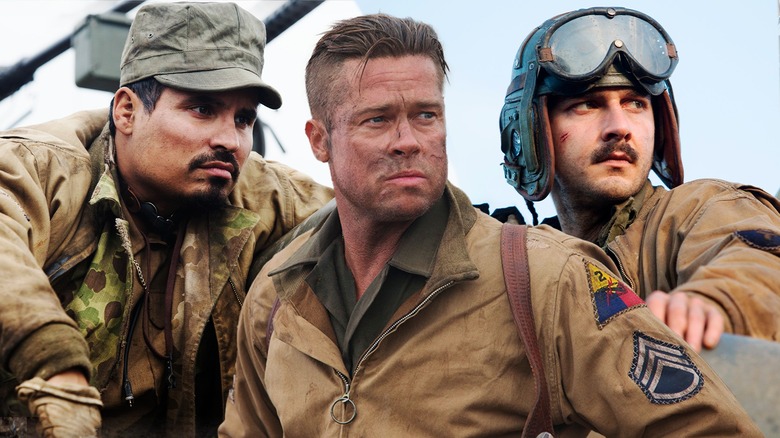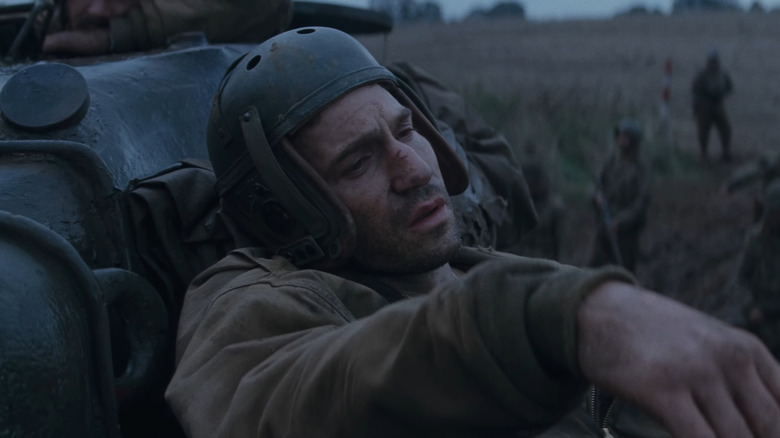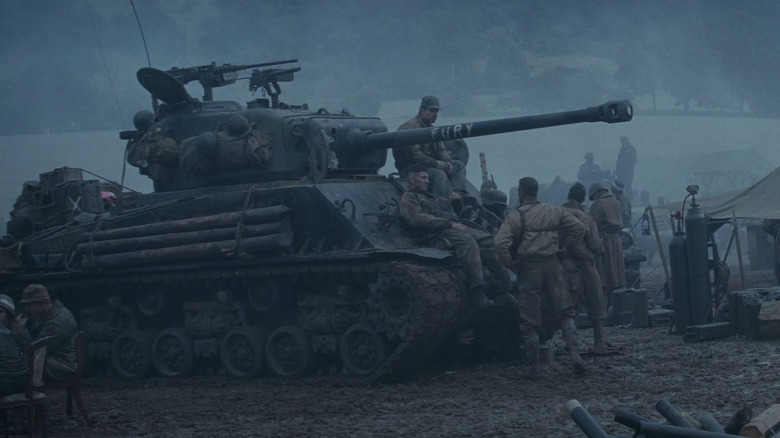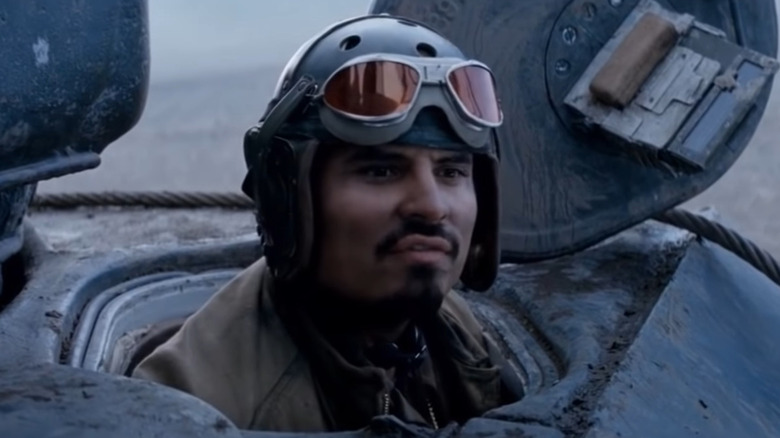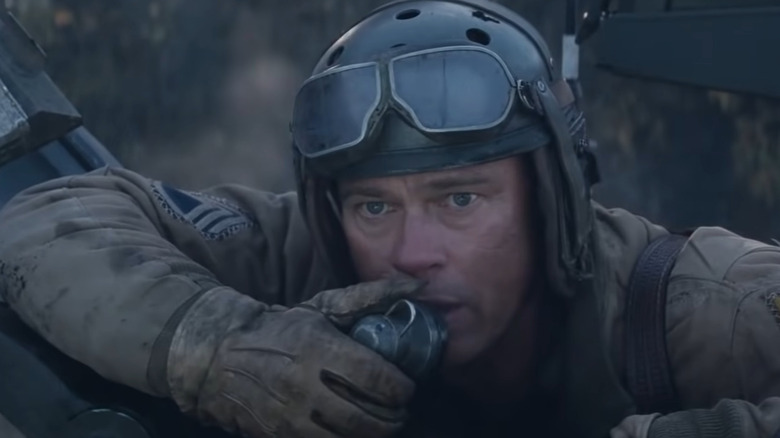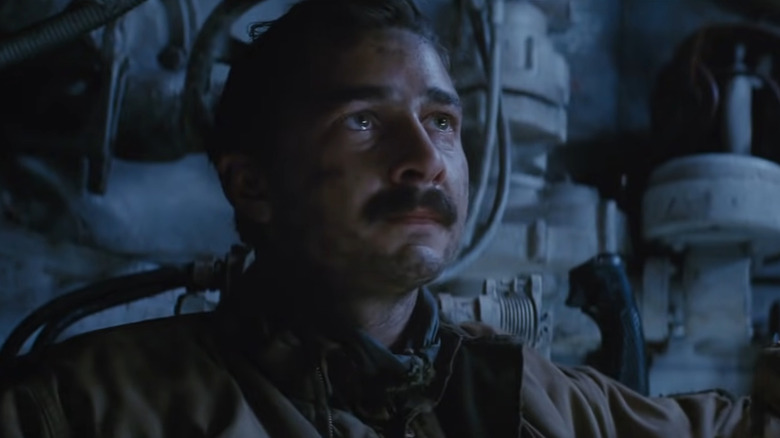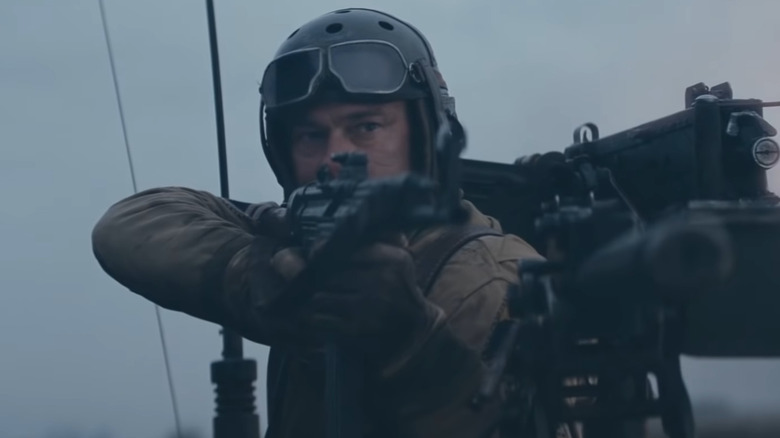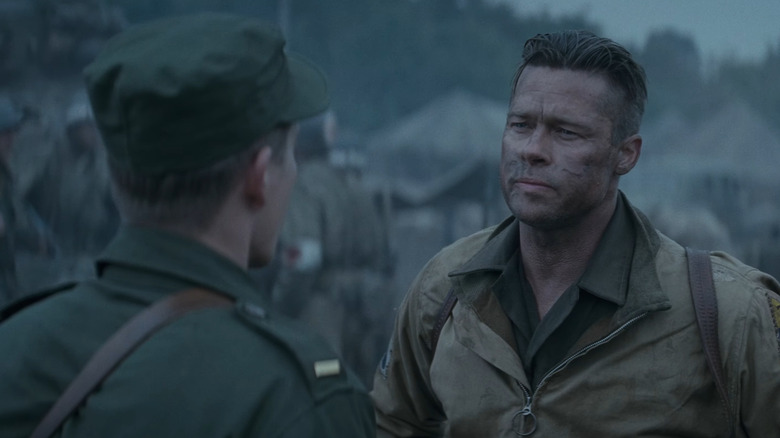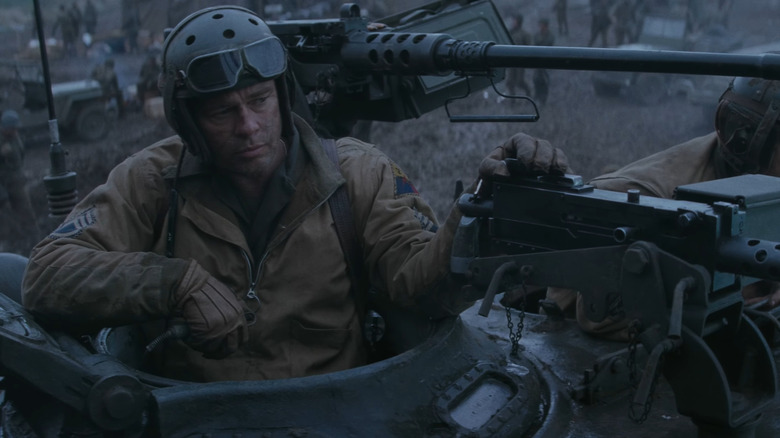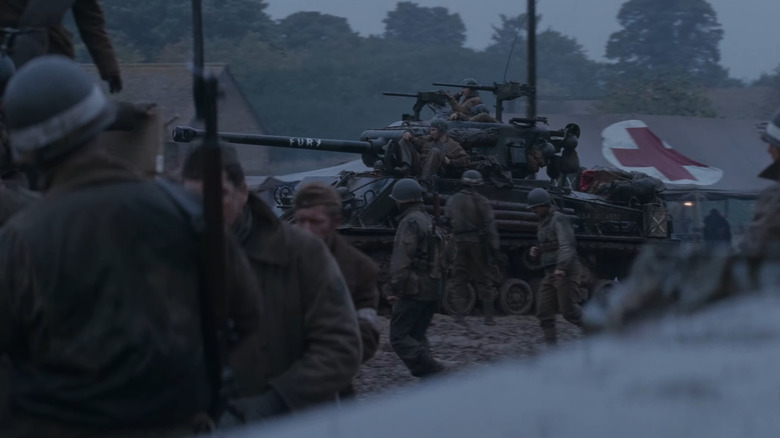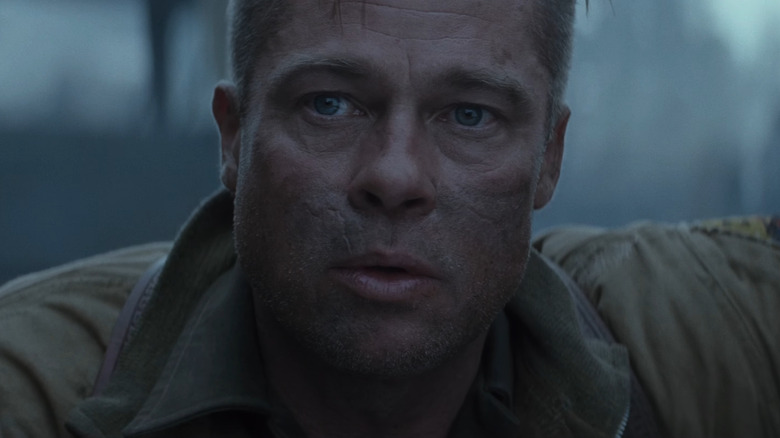Facts About Brad Pitt's Fury That Got Left In The Tank
War is hell, and all seven shades of that desolate and despairing underworld are captured in David Ayer's "Fury." It's there in the opening scene when Brad Pitt's character, Don "Wardaddy" Collier, leaps from a tank, knocks a German officer off a white horse, and stabs him furiously in the eye; and it's there in the epic last stand of his tight-knit tank crew. The audience is not given the chance to take a breath or collect their thoughts amidst the unfolding horror and never-ending carnage. The claustrophobic and tension-fueled atmosphere of life inside a killing machine — which could also become your coffin in the blink of an eye — is captured so effectively, the viewer has no choice but to be dragged through the hatch of Wardaddy's Sherman tank. The surreal and uncompromising world of Boyd (Shia LaBeouf), Norman (Logan Lerman), Gordo (Michael Peña), and Grady (Jon Bernthal), who fight to stay alive and retain some semblance of humanity in the last days of the Second World War, is not easily forgotten.
"Fury" specifically follows raw recruit Norman "Machine" Ellison, who's sent to join Wardaddy's battle-worn and weary tank crew in the Second Armored Division. His idealistic nature and fresh-faced morality clash with the experiences of this gang of veterans, who have fought together since the North African campaign. Soon, his naivete and inexperience threaten to become a dangerous liability. To survive the war, Norman must adopt a kill-or-be-killed attitude. "Fury" is a poignant, complex, and fascinating movie — and as it turns out, the story behind the scenes is just as interesting. These are the most compelling facts about "Fury."
David Ayer wanted Fury to portray the moral murkiness of warfare
Searching for sharply-defined moral certitudes in the burnt-out wrecks of bombed cities, the ruined shells of soldiers, the harrowing cries of the dying, and corpse-strewn battlefields is a fool's errand. There's no universal right or wrong in any mass warfare, just degrees of suffering. When tackling the experiences of a World War II tank crew, David Ayer wanted to capture this moral murkiness. The director explained to IndieWire that, as a veteran himself, he had become interested in how men deal with the trauma and stress of combat, and the ways in which they return home, still carrying the war inside them.
"Both my grandparents are from military and served in World War II," the director remarked. "My uncle flew 35 bomber missions over Germany. They never talked about it. There was always this mystery over what happened to these gentlemen." Ayer added he was keen to avoid the usual expectations of a WWII epic, instead staying true to the tales of men on the front lines. The war itself made this a fascinatingly complex proposition. "WWII was a black and white conflict," Ayer noted. "It really was good versus evil. That doesn't mean the fighting that these men experienced was black and white. It was incredibly morally murky." This attention to complexity paid off: After the film's premiere, a World War II veteran praised Ayer for the authenticity and accuracy of "Fury."
The cast underwent intense training
A tank crew fighting in the Second World War had to be fighting fit, possess an almost superhuman ability to roll with the punches, and keep their heads up, even when all seemed lost. To get into that particular frame of mind and develop tough physical prowess, Brad Pitt, Shia LaBeouf, Logan Lerman, Michael Peña, and Jon Berthnal underwent an intensive training regime tailored to break them down and put them back together again. While talking to IndieWire, Pitt explained that the cast immersed themselves in three months of training, which ended with a short stint in boot camp. Being around vets, sparring with one another, and becoming extremely familiar with tanks was all part of the process.
"It was structured to break us down," Pitt recalled, "to make us understand hardship, make us be cold, wet, hungry, physically exhausted and then gave us tasks that would bring us together." While rememebering the sleep deprivation and constant exercise, Peña noted such grueling treatment did indeed forge a solid bond between these co-stars. Members of the "Fury" cast even spent a couple of days at the National Training Center in Fort Irwin, California to help develop a connection with their roles. SFC Anthony White told Fox News that LaBeouf, who arrived in full uniform, was enthusiastic about getting into the training regimen. "Shia brought out a carton of cigarettes for the guys," White noted, "and was just very engaging ... And Brad was great too, asking the soldiers about their lives and families."
Michael Peña spent months learning to drive Sherman tanks
The M4 Sherman tank is a pretty iconic vehicle, and the chance to drive one doesn't come along all that often. When the opportunity to get his hands dirty and drive the real deal on the set of "Fury" presented itself, Michael Peña grabbed it with both hands. David Ayer told Parade that not only did Peña learn to drive tanks, in some instances, he operated them in lieu of the stunt driver. Peña had a knack for nailing all the tricky turns and stops that were asked of him. "He got really good at driving a tank," Ayer revealed. "It's kind of amazing."
Tank supervisor Jim Dowdall explained that Peña is a sharp driver who specifically knew what questions to ask, such as which gear he needed to be in at any given time. Peña admitted he was in awe of the size and power of the tank and its innate capacity for destruction. "I was definitely kind of skittish at first," the actor remarked, "but now, I've been driving it for so long, it's like, I just keep on driving, keep on driving. I can put it in second, third, fourth. It's actually a lot of fun when you go fast in a tank."
Fury was made in England over 12 weeks
"Fury" depicts the last days of World War II — specifically, the Allies' final push into Nazi Germany. But this movie was actually shot in England, over the course of 12 weeks. The Oxfordshire countryside was transformed as Sherman tanks roamed the meadows and woods in search of fictional Nazis. Hertfordshire's Bovington Airfield was used as a stand-in for the German town featured in the film. The "Fury" team picked the UK for many reasons, but some of the most compelling were the nation's deep crew base, its collection of armored vehicles from across the world, and its gorgeous light.
Sets were built to replicate the Sherman tank's exterior and interior, some of which were increased marginally in size to accommodate the practicalities of filming. Production designer Andrew Menzies explained to The Location Guide, "It's a very small set and every wall had to fly away, allowing David to shoot from any angle." The town where the dinner table scene is set was built over three months, and designed to stand up to the enormity of the tanks. Painstaking attention to detail is evident in all of these sets, though they range widely in terms of purpose and aesthetic. It pays off: "Fury" earned significant praise for its vividly real approach.
Shia LaBeouf suffered for his art
The cast of "Fury" was willing to put their bodies on the line for an authentic portrayal of a battle-hardened tank crew. However, Shia LaBeouf was willing to go one step beyond in a bid to do justice to the role of Boyd "Bible" Swan. The actor didn't believe the "Fury" make-up team was doing a good enough job, so he actually injured himself to get that all-important "combat veteran who hasn't had a decent night's kip in years" look. Co-star Logan Lerman told GQ, "They were putting cuts on Shia and I said, 'Yeah, yeah, it looks good.' And Shia was like, 'No, it doesn't look real.'" The next moment, LaBeouf asked Lerman if he wanted to see something funny. Then he cut his own face with a knife.
LaBeouf kept opening those cuts for the duration of the shoot, and — perhaps most shockingly — had one of his teeth ripped out by a dentist. It's also been alleged that the actor refused to shower for much of the production. In an interview with IndieWire, David Ayer praised LeBeouf's commitment. "Obviously there are crazy stories going around about him like he cut his arm off or he's flying around in a UFO," the director remarked, "but what they're not talking about is that he embedded himself in the National Guard for field exercises for a long time." By living with soldiers and studying the Bible, LaBeouf developed an instinctive understanding of war, and the role faith can play in it.
The unbelievable final battle is loosely based on real-life events
You can't beat a good last stand in the movies. It's where heroes are made, reputations are sealed, and legacies are forged in the heat and heart of the battle. There's something eternally inspiring about a person or group of people willing to face immeasurable odds and certain death in defense of something they value more than life itself. Those brave few who are willing to put themselves on the line to protect an ideal or the greater good speaks to something in the soul of us all. You see it when Wolverine goes into berserker mode at the end of "Logan," when Leonidas is killed in a hail of arrows in "300," and when Wardaddy and his crew go down in an epic blaze of glory defending their comrades from an SS battalion.
Only Norman survives the onslaught, but the Nazis' numbers are significantly thinned by the gallant actions of his fallen brothers-in-arms. It's tempting to dismiss this epic confrontation as pure Hollywood, but it actually has some basis in reality. On January 26 in the last year of the war, 2nd Lieutenant Audie L. Murphy positioned himself upon a burning tank and used its .50 caliber machine gun to hold off several hundred German troops and six tanks as his company withdrew into the nearby woods. The wounded 19-year-old held his position for over an hour before leading a counterattack and inflicting significant damage on the opposing forces. Murphy survived and was awarded the Medal of Honor for his actions. He would later earn acclaim as World War Two's most decorated soldier.
Fighting on the set of Fury
While making a film about the unforgiving horrors of war, David Ayer was adamant that the cast needed a challenging shared experience to bond them. As well as putting them through boot camp and making them live in a tank, Ayer insisted they do a little fighting to get them in the spirit. As he told IndieWire, "Five minutes of fighting is going to teach you more about a person than five weeks of conversation." Jon Bernthal told GQ that Pitt kicked him in a sensitive spot on three occasions, before he returned the favor with a huge hit to Pitt's guts. Obviously, in such a pressurized environment, tension is going to build and fists are going to fly. Pitt, Shia LaBeouf, and Scott Eastwood found this out the hard way.
Eastwood, who plays a minor part in "Fury," explained that he got into a heated argument with LaBeouf after spitting tobacco onto the tank. "I pretty much told him to f*** off, and Brad had to break it up," he explained. Pitt has a different recollection, and explained that after Eastwood spat on their tank, hackles were raised. Pitt demanded that Eastwood clean it up. When LaBeouf stepped in to back Pitt up, things escalated in a big way. Egos were bruised, but thankfully, no faces. Later on, Pitt and LaBeouf realized that Eastwood's spitting had all been in the script. "So we were the knobs in the end," explained Pitt.
Oxfordshire residents experienced loud and unexpected noises
Picture the scene. You're quaffing some homemade cider in your picturesque English garden and lazily admiring the sterling work you've done with this year's roses. Suddenly, the birds stop chirping, a shadow blots out the sun, and a low rumbling, followed by a very loud and unexpected boom, makes you drop your gin and tonic in shock. A long line of tanks approach. Your quaint little corner of Britain is under attack — not by the forces of aliens or a hostile country, but by a Hollywood film crew. This is the scenario that the inhabitants of leafy Shirburn faced when the cast of "Fury" rolled into town.
Residents of the sleepy hamlet in the Chiltern foothills were forewarned of the thundering sounds that would be coming their way when leaflets were posted through their letter boxes. According to The Guardian, a representative for the production company explained, "We wanted to warn people in advance so that they are not alarmed — but also, we don't want people ringing the emergency services!"
Actual tanks from World War II were used in Fury
Veteran Ray Stewart, a member of the 2nd Armored Division, traveled 1,000 miles from Normandy's Omaha Beach to Berlin as part of a tank crew. Two of the tanks he was in were destroyed along the way, but he survived the war. Many years later, he was interviewed by Brad Pitt, who wanted to get an idea of what life was like inside a Sherman tank. But that's not all "Fury" did to gain an authentic air. David Ayer wanted tanks that had actually seen action to go along with these first-hand war stories.
Although easily outgunned by German Tiger tanks, the Sherman tank more than proved its worth in combat, and has since gained iconic status. Designed in 1940, the Shermans made their debut in the North Africa campaign a year later. They led the charge during the D-Day landings, the liberation of France, and the march to Berlin. During the war years, 49,234 Sherman tanks were built — some of which, decades later, were used in "Fury." The tank owners even permitted Ayer to modify them for the film. A rare German Tiger tank was loaned by Bovington Tank Museum, much to the delight of Ayer. The director enthused to The Cinemaholic, "It's the only running German Tiger tank in the world. To have a battle with a real Tiger and real Sherman tanks coming at each other with pyro blowing off and explosions and everything — It was a once in a lifetime experience."
There was a real World War II tank commander nicknamed Wardaddy
Don "Wardaddy" Collier is one old-school tough son of a gun. He's also exactly the kind of guy you'd want in your corner when the bullets fly, bombs fall, and all hell breaks loose. His first priority is the welfare of his men. His second is to stop the Nazi war machine in its tracks. He does have moments of doubt and despair, but like all strong leaders, he doesn't let anyone else see them. He has a kind of easy-going and good-humored stoicism that inspires loyalty, and his ability to speak fluent German and knowledge of the Bible speaks of an impressive cultural background. Of course, that was earned long before he hardened himself to the realities of war. In the sprawling genre of war movies, he's one of the most memorable characters around — and he has a surprising foot in reality.
Staff Sgt. Lafayette "Wardaddy" G. Pool was in charge of a tank named "In The Mood," which was involved in the thick of things after the D-Day landings. Over the course of 79 days, In The Mood is said to have destroyed 12 tanks, taken out 258 armored vehicles and heavy guns, and killed 1,000 German soldiers. In The Mood ended its days by being blown into a ditch by a shell from a Panther. Wardaddy survived, but his leg was amputated. However, his nickname, deeds, and crew live on in "Fury."
